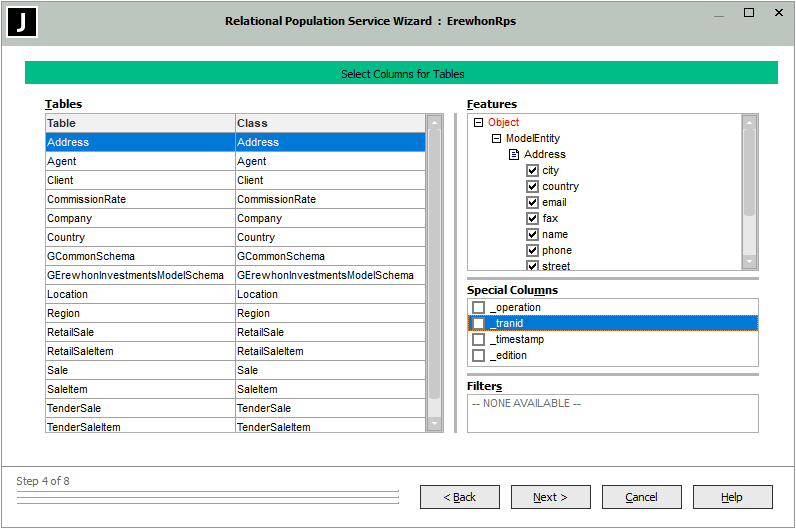Selecting Columns for Tables
The Select Columns for Tables sheet of the Relational Population Service wizard enables you to select the columns for your relational database tables and to specify filters.
An example of the Select Columns for Tables sheet is shown in the following image.
For details about refining the columns displayed on this sheet of the Relational Population Service wizard, see the following subsections.
To select columns for your relational database tables
-
In the Tables table, click on the row of the table whose features (attribute properties and column-mapping methods), special columns, or filters you want to refine.
The Features pane is then populated with all Jade attributes, single-valued references, condition-safe or all virtual properties (if the display of all virtual properties or only condition-safe virtual properties is selected), and column-mapping methods (if the display of methods is selected) defined in the selected class. If the table has subclasses mapped to it, the hierarchy node tree contains subclasses of the selected class and properties and column-mapping methods defined in those subclasses.
The properties (and methods, if selected) are sorted alphabetically with the properties first, followed by the methods that are also sorted alphabetically.
All Jade attributes and single-valued references in the Features pane are selected by default. Column-mapping methods and virtual properties are not selected by default.
The Filters pane is populated with all Jade condition methods on the selected class that can be used as filters for this table. No condition methods in the Filters pane are selected by default.
If the table has subclasses mapped to it, the Filters pane is populated with all Jade condition methods defined in the selected class and the hierarchy node tree contains subclasses of the selected class and condition methods defined in those subclasses, if applicable.
You can display tree lines in the Features and Filters panes. For details, see "Displaying Tree Lines in Features and Filters Panes", later in this chapter.
-
In the Features pane, uncheck the check box at the left of each Jade attribute and single-valued references that you want to exclude from the table column.
If virtual properties and column-mapping methods are displayed, check the check box at the left of each virtual property and column-mapping method that you want to include in the table column.
-
If you want the mapped table to include special columns, check the check box at the left of each of the special columns (that is, _operation, _tranid, _timestamp, and _edition) listed in the Special Columns pane that is to be included.
Historical tables, by default, always include the _edition, _operation, and _tranid special columns.
-
If you want a condition method to be used by RPS to filter object instances (for example, that the value must be over or under a specific amount), check the check box at the left of the condition method in the Filters pane that you want to apply. For a table mapped from a single class, you can select one condition method only.
If the table has subclasses mapped to it, you can select a condition method for each subclass.
A selected filter is evaluated as each operation is processed on the RPS node. An object instance is replicated to the target relational database only when the value of a condition is true.


